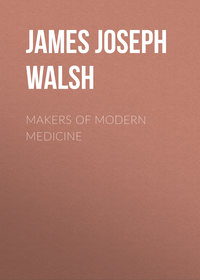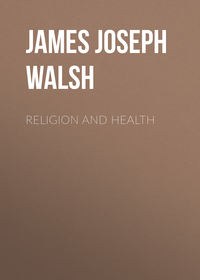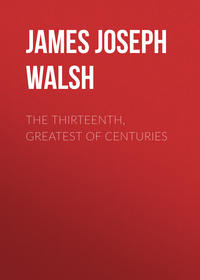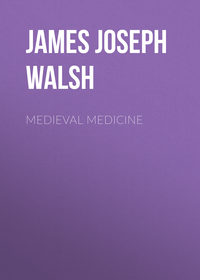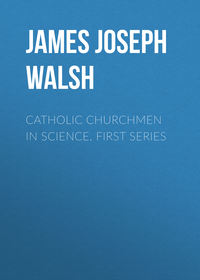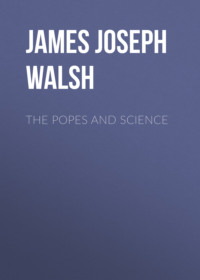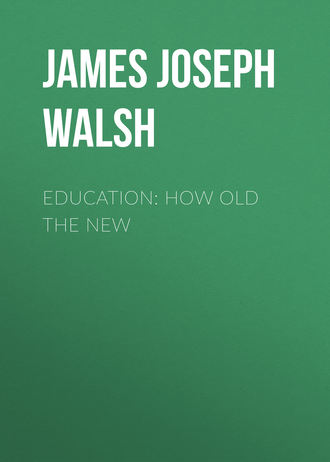 полная версия
полная версияEducation: How Old The New
We have demonstrated the indestructibility of matter in modern times by experimental methods. The mediaeval schoolmen reached similar conclusions, however, by strict reasoning from the premises of observation that they had in the olden times. We may be apt to think that they knew very little about nature and the details of physical science, but that will be only because we do not know their great books. Albertus Magnus is a typical example of a renowned teacher of the thirteenth century who was, however, at the same time a highly respected member of his order, holding important official positions in it and thoroughly honored and respected by his ecclesiastical superiors so that he was made a bishop, yet writing volumes of observation with regard to nearly every phase of physical science. A list of his books reads like a section of a catalogue of a library of physical science. I have told the story of his career in the second series of "Catholic Churchmen in Science," but the names of his volumes are sufficient to show what sort of work he was doing. He has volumes on chemistry, botany, on physics, on cosmography, on animal locomotion, on respiration, on generation and corruption, on age and death and life, on phases of psychology, the soul, sense and sensation, memory, sleep, the intellect and many another subject. Those who think that there was no attention paid to science in the Middle Ages must know nothing at all of Albertus Magnus' work.
Above all, those who talk thus are entirely ignorant of all that Roger Bacon did. Roger Bacon himself was a student of the University of Paris. He was a professor there. He corresponded with the scientists of Europe quite as frequently or at least as significantly as professors of the modern time do with each other. Students submitted their discoveries to him. We have Peregrinus' letter to him with regard to magnetism and electricity and know of others. We have his own books, in which he treats not only the scientific problems, but inventions and applied science of all kinds. At the present time his interest in aeronautics has a special appeal to us. He was sure that men would sometime make a successful airship. He even thought that he could make one himself, but his experiments proved unsuccessful. His theory of it was very interesting. In his work "De Secretis Artis et Naturae Operibus" he writes that a machine could be constructed in which a man sitting in the centre might move wings by means of a crank and thus, quite after the fashion of birds, fly through the air. It was he who wrote that the time would come when carriages would move along the roads without men or horses to pull them. At the moment he was experimenting with gunpowder. He realized, therefore, that sometime men would harness explosives and use them for motor purposes. That is, of course, just what we are doing with gasolene.
He suggested that boats would run over the water without oars and without sails. He was anticipating our motor boat. He taught that light moves with a definite rate of velocity, though that fact was not demonstrated for several centuries after his time. He worked out most of the theory of lenses as we have it at the present time. He was sure that experiment and observation constituted the only way by which knowledge of nature could be obtained. In this he was but following his great teacher Albertus Magnus, who insisted that in natural philosophy experiment alone brought sure knowledge; "Experimentum solum certificat in talibus." are his own words. Roger Bacon's devotion to mathematics shows how thoroughly scientific was the trend of his mind. Without mathematics he was sure that one could not reach scientific knowledge, or that what one did get was without certainty. Some of his expressions in this matter are strikingly modern. It is no wonder that his writings and teachings were so great a surprise to his generation that the Pope ordered him to write out his knowledge in books. Without this order we would not have had Roger Bacon's great works, for his vow of poverty voluntarily taken forbade him to be possessed of sufficient money to enable him to purchase writing materials, which were then very expensive.
Indeed the mathematics of the mediaeval universities is the best proof of the seriousness of their devotion to science and, may it also be said, of their success. Cantor, in his "History of Mathematics," and he is the great authority in the matter, devotes nearly 100 pages of his second volume to the mathematicians of the thirteenth century alone, two of whom, Leonard of Pisa and Jordanus Nemorarius, did so much in arithmetic, in the theory of numbers, and in geometry, as to work a revolution in mathematics. They had great disciples like John of Holywood (probably a town near Dublin), Johannes Campanus and others. No wonder that at the end of the century Roger Bacon said, "For without mathematics nothing worth knowing in philosophy can be obtained," and again, "for he who knows not mathematics cannot know any other science; what is more, he cannot discover his own ignorance or find its proper remedy." The fourteenth and fifteenth centuries saw even more important work done. Cantor has half a dozen men in the fifteenth century to whom he devotes more than twenty-five pages each. How the place of this in mediaeval teaching can have escaped the notice of those who insist so much on the neglect of science during the Middle Ages, is hard to understand. This alone would convict them of ignorance of what they are talking about.
The educational genius of the great university century, the thirteenth, the man who influenced his contemporaries and succeeding generations more than any other, was Thomas Aquinas, to whom the Church, for his knowledge and goodness, gave the title of saint. If any further proof that these centuries were interested in science were needed, or that the universities in which he was the leading light as scholar and professor in the thirteenth century, and as the great master to whom all looked reverentially after, were developing scientific studies, it would be found in his works. Philosophy is developed scientifically in his "Contra Gentes" and theology, scientifically in his great "Summa." It is the very austerity of the scientific qualities of these books that have made them forbidding for many modern readers, who, therefore, have failed to understand the scientific spirit of the time. St. Thomas Aquinas, however, was, as I suggested at the beginning of this, deeply interested in every form of information with regard to what we now call physical science. He evidently drank in with avidity all that had been observed with regard to living creatures and, when we come to analyze his works with care and read his books with the devotion of his own students, we find many anticipations of what is most modern in our science.
The indestructibility of matter, matter and form, that is the doctrine of the unity of the basis of matter, the conservation of energy in the sense that the forms of matter change but do not disappear, all these were commonplaces in his thought and teaching. I have recently had occasion to point out how close he came to that thought in modern biology which is probably considered to be one of our most modern contributions to the theory of evolution. It is expressed by the formula of Herbert Spencer, "Ontogeny recapitulates phylogeny." According to this the completed human being repeats in the course of its development the history of the race, that is to say, the varying phases of foetal development in the human embryo, from the single cell in which it originates up to the perfect being as it is born into the world, retrace the history by which from the single-cell being man has gradually developed. The whole theory of evolution is supposed by many people to be modern, but of course it is not. This particular phase of it, however, is thought surely to be modern. It is sometimes spoken of as the fundamental law of biogeny. In recent years serious doubts have been thrown on it, but with that we have nothing to do here.
It is very curious to find, however, that St. Thomas, in his teaching with regard to the origin and development of the human being, says, almost exactly, what the most ardent supporters of this so-called fundamental biogenetic law proclaimed in recent years. He says that "the higher a form is in the scale of being and the farther it is removed from mere material form, the more intermediate forms must be passed through before the finally perfect form is reached. Therefore, in the generation of animal and man–these having the most perfect forms–there occur many intermediate forms in generations and consequently destruction, because the generation of one being is the destruction of another." St. Thomas does not hesitate to draw his conclusions from this doctrine without hesitation. He proclaims that the human material is first animated by a vegetative soul or principle of life, and then by an animal soul and only ultimately, when the matter has been properly prepared for it, by a rational soul. He said:
"The vegetative soul, therefore, which is first in the embryo, while it lives the life of a plant, is destroyed, and there succeeds a more perfect soul, which is at once nutrient and sentient, and for that time the embryo lives the life of an animal: upon the destruction of this there succeeds the rational soul, infused from without."
His discussion of the position of the Church and of faith to science is extremely interesting, because here once more he faces a modern problem. Aquinas was very sensitive with regard to the imposition upon Christians of things which supposedly they had to believe on the score of faith, though they were really not of faith at all. Some of his expressions in this matter are very strong and he was especially fond of quoting St. Augustine, who was very emphatic on this point. One of these typical passages deserves to find a place here because, while the word philosophy is used, it is evidently science in our modern sense of the word that is intended. Augustine talks of what the philosophers have said of the heavens or the stars and the motion of the sun and moon, meaning of course the astronomers, who were in the old days classed as natural philosophers. This passage, then, which contains the opinions of the two greatest teachers of the Church in the West may well serve as a guide for those who are interested in science, and a warning for those who would obtrude faith too far into scientific questions, and thus limit investigation and hamper that freedom of intellect which is so important for the development of science. St. Thomas said in his introduction to the reply to Master John of Vercelli:
"I have endeavored to reply but with this protest at the outset, that many of these articles do not pertain to the teachings of faith, but rather to the dogmas of the philosophers. But it works a great injury either to assert or deny as belonging to sacred doctrine such things as do not bear upon the doctrine of piety. For Augustine says, 'When I hear certain Christians ignorant of those things (namely, what philosophers have said of the heavens, or the stars, or the motion of the sun and moon) or misunderstanding them, I look with patience upon such men: nor do I see any reason to hinder them, when of thee, Lord Creator of all things, they do not believe unworthy things, if perhaps they be ignorant of the structure, and condition of corporal creatures. But they are a hindrance if they think these things belong to the very doctrine of piety; and more, pertinaciously, dare to affirm that of which they are ignorant.' But that they may be the cause of injury Augustine shows. 'It is very disgraceful,' he says, 'and pernicious and especially to be avoided, that a Christian speaking of these things as though according to Christian teaching should so rave that any infidel may hear; so that, as it is said, seeing him altogether in the wrong, he may scarcely contain his mirth. And it is not so hurtful that one man should be seen to err, as that our writers are believed by those who are without [the Church] to have such opinions, and to the ruin of those whose salvation is our care they are scorned and contemned as unlearned.' Whence it seems safer to me that those things which philosophers have commonly held, and are not repugnant to our faith, should neither be asserted as dogmas of faith, although at times they may be introduced under the names of the philosophers, nor so denied as contrary to the faith, as to give occasion to the wise of this world of contemning the teaching of the faith."
Is it any wonder that Professor Saintsbury of the University of Edinburgh, whose training in the old Scotch universities has given him a breadth of sympathy not common in our time, and whose wide knowledge of the literature of that period as well as its philosophy and education, and whose training in the discussion of the criticism of all time in his "History of Criticism" has made his opinion of special value, should have sympathetically turned to these old teachers and deprecated a little bitterly the modern attitude towards them? He said:
"Yet there has always in generous souls who have some tincture of philosophy, subsisted a curious kind of sympathy and yearning over the work of these generations of mainly disinterested scholars, who, whatever they were, were thorough, and whatever they could not do, could think. And there have even, in these latter days, been some graceless ones who have asked whether the science of the nineteenth century, after an equal interval, will be of any more positive value–whether it will not have even less comparative interest than that which appertains to the scholasticism of the thirteenth."
I have always considered, however, that the easiest way to show the modern student of science how supremely scientific in his temper was St. Thomas, is to quote for him the passage from that great teacher with regard to the Resurrection. In every way, that is typically modern. St. Thomas faces the question that after death men's bodies decay, the material of them is taken up and used in many other living beings, so that how can we dare to believe that we shall rise again on the last day with the same bodies that we now have? St. Thomas discusses this knotty problem straightforwardly and solves it more satisfactorily, even for all the knowledge that we have of it now, than has ever been done.
"What does not bar numerical unity in a man while he lives on uninterruptedly clearly can be no bar to the identity of the arisen man with the man that was. In a man's body while he lives there are not only the same parts in respect of matter, but also in respect of species. In respect of matter there is a flux and reflux of parts. Still that fact does not bar the man's numerical unity from the beginning to the end of his life. The form and species of the several parts continue throughout life, but the matter of the parts is dissolved by the natural heat, and new matter accrues through nourishment. Yet the man is not numerically different by the difference of his component parts at different ages, although it is true that the material composition of the man at one stage of his life is not his material composition at another. Addition is made from without to the stature of a boy without prejudice to his identity, for the boy and the adult are numerically the same man."
The most important feature of the scientific teachings of the mediaeval universities has been left till the last because it is the clinching confirmation of a claim that these were essentially scientific universities. It is to be found in the position of the medical schools and the state of medical teaching during the Middle Ages. So curiously has the history of education been written, and, above all, of medical education, that to most people this would seem to be surely the department of education which would prove just the opposite. We have heard so much about Church opposition to anatomy and Church opposition to surgery, of its repression of the development of medical science and even medical art, because the Church wanted to make people believe in the value of masses, relics and prayers–and pay for them–that most people are quite sure that there was no medical education of any significance in the Middle Ages. Nothing shows more clearly how viciously the history of education has been written than the existence of such false impressions. Not only are they utterly unfounded, but they are based on supreme ignorance of one of the greatest periods in the history of medicine that we have in all the world's history. Not only were the schools excellent and the teaching progressive, but there was a fine development of medical science and, above all, of surgery. Surgery is supposed to be particularly the department of medicine that did not develop. We have learned better in recent years, and now we know that there was no greater period in the history of surgery than that from 1200 to 1400 when, alas! following so-called history, we used to think there was no surgery.
The first question that any one who knows anything about the subject asks with regard to the progress in medicine of a particular time or country is, what was the standard of its medical education? What was the standard of admission to the medical schools, how many years of medical studies were required? To this question the Middle Ages have a wonderful answer that has not been realized until recent years. We now have Frederick II's famous law for the regulation of the practice of medicine and the maintaining of standards in medical schools. This law was promulgated in the Two Sicilies, the southern part of Italy and Sicily proper. According to it no one was allowed to practise medicine who had not studied for four years in a recognized university and then practised for one year with a physician before receiving his license to practise by himself. If he wanted to practise surgery he had to spend an additional special year in the study of anatomy. The university medical schools were graduate schools and did not admit a student unless he had completed the undergraduate course.
Of course it may be thought that this was due entirely to the great Emperor Frederick, who was far ahead of his time and who, therefore, anticipated the progress of medical teaching by many centuries. We have, however, many other documents which illustrate the state of medical education at this time. The charters of the medical schools were granted by the Popes and were very explicit in what they required of the new faculties in order that standards might be maintained. Pope John XXII, for instance, at the beginning of the fourteenth century, issued charters for medical schools at Perugia and Cahors. He required that there should be four years of medical study and three years of preliminary work. He went into details to secure the maintenance of standards. The original faculties of these schools would all have to be doctors in medicine from either Paris or Bologna, and it must be their duty to establish in the new schools the standards of their Almae Matres. Examinations were to be conducted under oath, men were not to be granted degrees unless they deserved them, the votes of professors rejecting candidates or graduating them were to be under oath-bound secrecy, so as to have them absolutely free from personal influence, and every precaution was taken to secure the highest possible standards.
It was as a consequence of their direct attachment to these old mediaeval medical schools that the medical schools founded here in America in the sixteenth century at once began with high standards. Three years of preliminary work was required and four years of medicine. In the United States no preliminary requirements were demanded; and for a full century only two years of medical study, which really consisted of but two terms of four months each, was the requirement. The old mediaeval medical schools were originally attached to the universities, and it is a well-known rule in the history of education that whenever the medical schools are independent then standards are sure to be low. Whenever the university controls the medical school and it is a real graduate department, then standards of admission and of graduation are properly maintained. It is surprising to think that the old mediaeval universities should be able to give us lessons in this matter and should put us to shame for our slip-shod nineteenth-century medical education in the United States, but this is a simple fact. Contrast the South American countries where the mediaeval traditions with which they were founded constrained them to give four, five and even six years to medicine before granting a degree. Go a step further and see how devoted to science were the Universities of Lima (Peru) and Mexico, centuries before we did any serious scientific work in the United States, and all because they were direct descendants of the old mediaeval universities.
The feeling of certain modern educators would be that it did not matter how much time these mediaeval universities gave to medicine since, after all, they had nothing of any value to teach in medicine. Even educated people have been led to believe that there was nothing in medicine and, above all, in the surgery of those times to be of any value. Probably no opinion is more foolishly ignorant or more ridiculously absurd than this, though it is a commonplace among people who are sure they know something about history, and, above all, among those who consider themselves authorities in the history of education, and of the development of science. In surgery a magnificent development was made at this time of which I shall have something to say later. In medicine there was much less anticipation of our modern progress, but even here there was much that demands our respect. One of the university men, Simon of Genoa, worked out the dosage of opium and indicated its uses. Anodyne drugs were employed much more generally and successfully than we are apt to think; various methods of anaesthesia, one of them by inhalation, of which I shall say more when talking of surgery, were invented and a large number of drugs and simples were experimented with. Down at Montpellier Bernard Gordon suggested red light for smallpox.
This is not much of a record, perhaps, but we must not forget what Professor Richet, the Director of the Physiological Laboratory of the University of Paris, said not long since in an article on "Physicians and Medicine" in La Revue de Deux Mondes. It is startling but chasteningly true. "The therapeutics of any generation has always been quite absurd to the second succeeding generation." Indeed it is one of the almost disheartening things in the history of medicine to see how treatments come in, are widely accepted and hailed as great advances in therapeutics and then gradually disappear. They bled a great deal and they purged not a little, in accordance with the teaching in the medical schools of the universities of the thirteenth and fourteenth centuries, but then they bled a great deal and purged a great deal more, according to the teaching of the medical schools of the beginning of the nineteenth century. There have been many periods in the interval when purging and bleeding were, and very properly, not nearly so popular.
It was in preventive medicine particularly that these progressive medical men of the early university days secured their triumphs. They made separate hospitals for the lepers all over Europe, and by segregation succeeded in wiping out that disease, though it was as widely spread as tuberculosis in our day and presented just as serious a problem. Indeed the most encouraging incentive for our present tuberculosis campaign is drawn by many authorities from the experience with leprosy, which was eventually obliterated as an endemic popular disease, by strict segregation methods. These same generations created special hospitals for erysipelas and thus prevented the spread of this disease in the ordinary hospitals, where it used to be so serious a factor for morbidity if not for mortality. Men forgot this later and the disease became a serious problem once more in all the hospitals of even a generation ago. The hospital organization worked out by these university men is the finest jewel in the crown of their accomplishment as applied scientists. Pope Innocent III, himself a University of Paris man, founded the Santo Spirito Hospital in Rome, summoning for that purpose the best authority on hospitals in Europe, Guy of Montpellier, and then required the bishops of the world to erect similar hospitals in their dioceses. This was done, and it is Virchow, whose sympathies were anything but favorable to the Popes, who has been most loud in his praise of the wonderful hospital organization of these centuries. Every town in Europe of 5,000 inhabitants or more had a hospital, and there were hospitals in many of the smaller towns.





